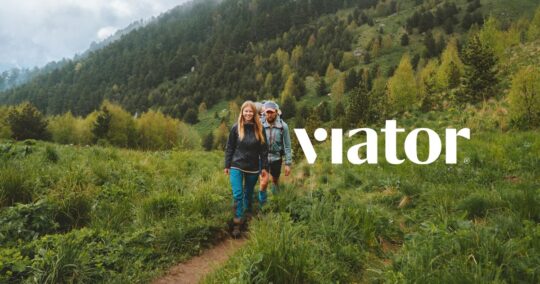What’s the most important page on your website? It’s not your homepage. It’s not even your About page. It’s your booking page.
Why? Because that’s where the conversions happen!
And the best booking page design influences a guest’s buying behaviour by reflecting their needs and expectations while increasing the perceived value of your products through visual appeal.
So, if you’re wondering why visitors aren’t booking, it’s very possible that they’re not excited about how your page looks, or worse, are too confused by the layout and have no idea where to find the next steps.
But before you go and overhaul your page or purchase a new booking page design template, let’s go over the essential elements you need to boost your conversion rate:
10 must-have elements of a booking page (with an example)
1. Visual hierarchy
Any web page should follow an organized visual hierarchy that guides visitors to influential content that entices them to take a desired action. The best way to do that is to follow typical eye-tracking behaviour.
For the booking page design, the Z pattern and F pattern are the most commonly used layouts based on cultures that read top to bottom, left to right. In other words, the visitor forms an imaginary Z or F shape as they scan and scroll, processing key information along the way.
See for yourself. Open your current booking page — or homepage if you don’t have one yet — and draw the pattern your eyes follow as you make your way down to the footer.
- What does it look like?
- What do you notice right away?
- Where do your eyes stop?
Now, take a look at the below examples of a booking page design that follows the Z pattern and F pattern.
Z pattern

The eyes read the headline, follow a diagonal line down to the availability calendar and search bar, then browse the products left to right before repeating the shape.
F pattern

The eyes notice the availability calendar first, then scroll down the products stacked on top of each other, reading the price, name, and description horizontally.
Doesn’t it flow more naturally?
2. Captivating headline
A headline is the first thing a visitor sees upon landing on your booking page. Whether they get there from a Google search, social media campaign, or your homepage, the headline plays a crucial role in preventing them from bouncing right away.
It needs to grab their attention, let them know that they’re in the right place, and tempt them to continue scrolling. The better your headline, the better your conversion rate.
But that’s a lot of pressure to put on 6-12 words, especially when you also have to squeeze in a primary keyword for SEO. And it can be intimidating trying to come up with something good if you don’t have any experience with conversion copywriting.
Here’s the thing. No one can come up with the perfect headline just like that. It takes practice, and the most effective approach is to brainstorm a bunch of options by following un-cheesy headline formulas that work:
1. Say what it is
Get straight to the point by addressing the type of experiences they’ll find on the page.

2. Say what you can do
Point out at least one unique thing they’re going to see or do during the experience.

3. Say what you get
Lead with a benefit that sums up the emotional value from having the experience.

3. Hero image or video
A hero image is the large cover photo that sits above the fold, spanning the full width of the page, like a banner, with the headline overlaying.
Why do you need one for your booking page design? Because people respond positively to visual content and the right image can arrest a visitor’s attention, help them visualize the experience, and evoke the fear-of-missing-out emotion that drives them to book.
How do you pick a good hero image?
- Go with a high-quality, professional photo
- Use an original image to promote brand authenticity
- Showcase your most popular experience or top attraction
- Include people to elicit an emotional response based on facial expressions
- Ensure the colour doesn’t compete with the headline
- Follow recommended hero image specs
Also, don’t be afraid to use a promo video over a hero image because that’ll invite the visitor into the action even more. Just make sure to optimize for fast page loading time.
4. Live availability calendar
When a visitor lands on your booking page, they might not know what they’re looking for yet, but they usually have a day in mind already. So before they pick an experience, it’s best to get the date out of the way by putting your availability calendar as the first step.
Otherwise, someone might see an experience they’re interested in, get emotionally invested and ready to book, only to find out that it’s sold out for when they want to go. And because they’re attached to the idea already, they might not go back to the drawing board but instead look to see if another operator in town offers something similar.
Whereas guiding them to select the date right away makes it so they can look at the options objectively based on availability, and then follow their heart’s desire.

5. Organized categories
If you offer multiple types of experiences, ranging from accommodation to tours to rentals, it’s a good idea to organize your products according to the appropriate category. Doing this accelerates the booking process because visitors can narrow their search from the get-go rather than spending time sifting through a long list of options.
Even if you only do one thing, you might have a wide variety of categories within your product collection. For example, let’s say you sell mountain bike rentals. You could organize your categories by bike type, experience level, or brand name. Or if you offer bus tours, you could sort the options according to the duration or main attraction.
There are three ways to display categories on your booking page for optimal usability:
Visual grid

Drop-down menu

Tabs

We recommend the visual grid or the drop-down menu for a clean and sleek design, especially if you have more than 10 categories, but it’s up to your personal preference.
6. Clear product names
A common mistake operators make when naming their products is they either get too fancy or make it excessively long by including all of the essential details. Save that for the product description!
Here are two examples to show you what I mean:
4 Hour Bus Tour of London with Local Guide and Changing of the Guard Ceremony at Buckingham Palace
Not only did you lose me at 4 hour walking tour, but you’ll also struggle to add that product to OTA sites because the name might not pass their quality check due to length.
The Classic London Experience With an Up-Close Look at History
Looking at the name alone, I would have no idea what the experience is or what it entails. I’d skip right over it because there’s no mention of a tour, and that’s what I want.
So, how do you come up with the perfect product name?
My advice: turn to Google. Look at the queries people use to find your experiences and then use precisely that terminology. In doing so, you’ll get SEO value while also meeting the user’s intent with an exact match product name. Of course, you can always spruce it up with one or two adjectives; just don’t go overboard.
Double Decker Bus Tour of London’s Must-See Attractions
See the difference? Keep it simple.
7. Upfront prices
Some operators choose to hide their pricing until right before checkout, so cost is never the number one factor in the booking decision. They want to demonstrate the product’s value before scaring away a potential guest because of sticker shock.
But I don’t necessarily agree with that strategy. Your brand should already do that. Besides, if budget is the only thing on a guest’s mind, they’ll drop off when they see the total anyway, whether it’s at the beginning of the booking process or the end. And wouldn’t you rather weed out the bargain shoppers from the start?
Plus, there are many benefits to being upfront with your pricing:
- You answer the question of cost, which saves the visitor time from hunting for the price, unaware it’s hidden for a reason
- You build trust; consumers are more conscientious today and lean towards brands that represent honesty and integrity
- You appear confident; it shows that you stand behind your prices, knowing with 100% certainty they reflect the overall value
P.S. You can show the starting price, price range, and even show the total in your guest’s local currency using Currency Display.

8. Spots left
Most of us are procrastinators. We’ll sit on a decision until the very last minute, justifying that we need more time to think it over. But usually, we just haven’t been convinced to act now because there’s no reason to rush.
Hands down, your visitors do this too. And I wouldn’t be surprised if the majority of them go to your booking page with good intentions but decide to wait and never come back because they forget where they found your experiences in the first place.
Well, there’s good news. You can actually do something to combat this behaviour. It’s called scarcity marketing; a tactic that creates urgency by showing a limited time offer or quantity. And it works so well because people associate a short supply with popularity.
So, if you display the number of spots left per product, the ones that are close to selling out will attract more attention because people will want to book them right away before losing their chance. It’s an excellent strategy to reach full capacity.

9. Product descriptions
The purpose of a product description is to sell the experience. But I often see operators simply list out the important features and nothing more. While doing this answers the question, “what’s included?” effectively, it doesn’t exactly make the offer irresistible.
Instead, it helps to think of a product description as your one and only opportunity to convince someone to book. And the best way to do that is to make the description enticing, persuasive, informative and optimized.
Here are some tips on how to write a tour description:
- Speak to your audience: stick with a tone they can relate to, and use a second-person point of view (i.e. “you” language)
- Start with a hook: lure them in with a strong statement that identifies what’s in it for them based on an emotional benefit
- Take them on a journey: let them know what to expect by describing the unique things they’ll see and do from start to finish
- Show don’t tell: pull them into the action by using verbs over adjectives to engage their senses and emotions
- Break up the details: bullet point key information underneath appropriate sub-headings, such as “what to bring” or “inclusions”
- Remember keywords: optimize the copy for Google by naturally working in relevant long-tail keywords
- Use photo examples: back up your description with supporting photos that highlight the best parts of the experience

10. Book Now button
Finally, every booking page design needs a call to action (CTA), representing the next step you want them to take. While you might be tempted to use creative copy here, I strongly suggest keeping it simple with the most commonly used Book Now CTA.
Why? Because your guests are already familiar with this wording from booking hotels and other experiences. Sure, Dive in or Start Exploring may sound cool, but it can be confusing. What are they exploring if they click — more information? On the other hand, Book Now is clear, direct, and puts them into the mindset to convert, now.

Final thoughts
By including the above elements on your booking page, followed by an integrated booking flow, you should start to see better results. Just remember that website optimization best practices always change, so monitor the performance of your booking page regularly and split test every change you make.
Looking for a booking page design that has all of the above?

Take your business to the next level
Online bookings. Flexible pricing. Outstanding support.



